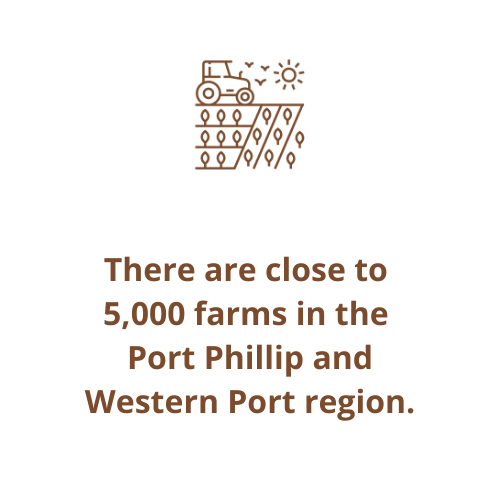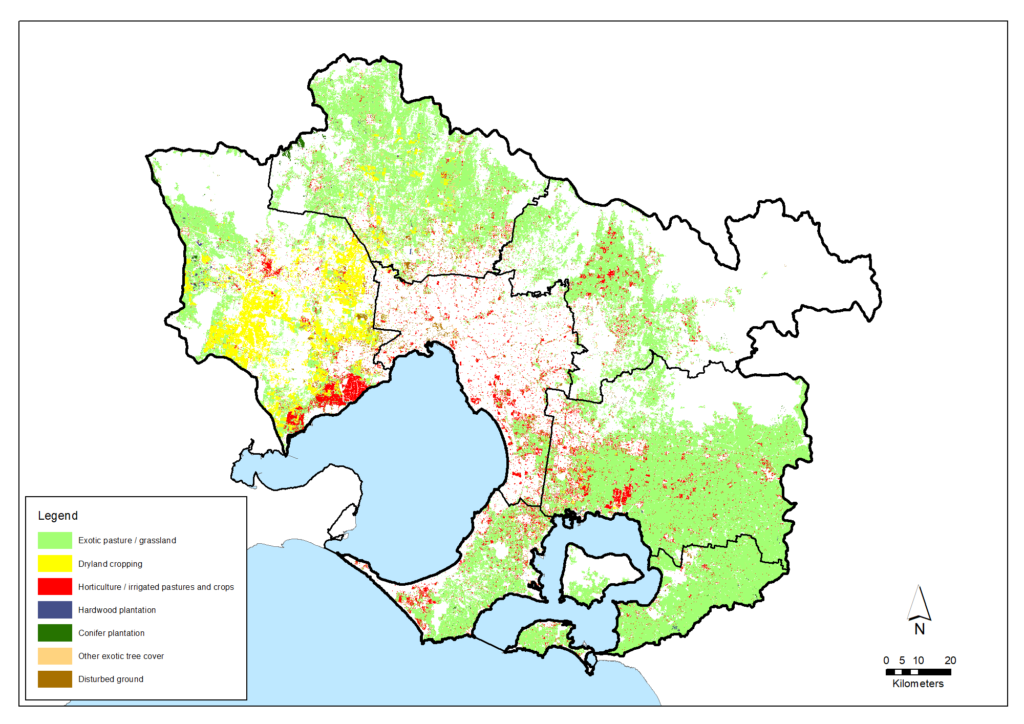Our local foodbowl
The Port Phillip & Western Port region produces a significant amount of fresh food and other produce in its green wedges, peri-urban fringe and outer rural areas with diverse agricultural industries.
‘Melbourne’s foodbowl’ includes well-known areas such as the Yarra Valley and the Mornington Peninsula, plus numerous highly productive areas such as Cranbourne and Koo Wee Rup in the south-east and the Werribee and Bacchus Marsh irrigation districts in the west.
The diversity, profitability and sustainability of agriculture in this region is important for Melbourne and Victoria. Its values include food production close to home, economic and employment benefits, plus the provision of ‘green space’ in and near the urban landscape, biodiversity benefits, carbon sequestration and water retention in the landscape.
Agriculture in this region today
Of the 1.28 million hectares of land in the region, around 44 per cent is agricultural with significant industries including horticulture, dairying, poultry farming, beef farming, horse management and viticulture. The region had gross value of production of $1.66 billion in 2018-19 which is among the highest for Victoria’s regions.
Significant commodities in the region based on the gross value of agricultural production included nurseries ($286 million), poultry ($168 million) and mushrooms ($102 million).
Although this region has a significant urban area, it produces 23 per cent of Victoria’s vegetables, seven per cent of Victoria’s fruit (including 96 per cent of its berry fruits), 59 per cent of the state’s chicken meat and over a third of its eggs. The area currently produces around 41 per cent of Melbourne’s fresh produce needs.
Parts of the region are significant for particular crops as a result of their climate, soil, and other conditions. For example, a University of Melbourne report states the Yarra Valley produces 78 per cent of Victoria’s strawberries and Koo Wee Rup grows over 90 per cent of Australia’s asparagus.
The table and map below summarise agriculture data for this region. Further detail is available in the agriculture data section of this website.
Agriculture data for 2015-16 (from Australian Bureau of Statistics Agricultural Census)
| Data from 2015-16 | Bass Coast, South Gippsland & islands | Casey, Cardinia & Baw Baw | Mornington Peninsula | Yarra Ranges & Nillumbik | Urban Melbourne | Macedon Ranges, Hume, Mitchell & Whittlesea | Melton, Moorabool, Wyndham & Greater Geelong | Total |
|---|---|---|---|---|---|---|---|---|
| Local Area (Hectares) | 84,919 | 237,926 | 72,004 | 264,786 | 145,391 | 221,779 | 251,541 | 1,278,346 |
| Area of agriculture (Hectares) | 60,441 (71%) | 155,610 (65%) | 38,864 (54%) | 62,140 (23%) | 23,223 (16%) | 120,005 (54%) | 103,851 (41%) | 564,134 (44%) |
| Number of farms | 662 | 1,749 | 422 | 769 | 156 | 500 | 588 | 4,846 |
| Employment on farms | 1,070 | 4,787 | 1,922 | 3,246 | 8,655 | 2,189 | 2,277 | 24,146 |
| Gross value of annual agricultural production ($) | $96 million | $681 million | $199 million | $280 million | $84 million | $116 million | $207 million | $1.66 billion |
| Main agricultural commodities | Dairy, beef | Dairy, beef, poultry, vegetables, nurseries | Poultry, fruits and nuts, vegetables | Fruits and nuts, vegetables, nurseries | Vegetables, nurseries | Beef, vegetables | Grains, sheep meat and wool, poultry, pork, vegetables |
Policy and planning
The Australian Government has announced its Ag2030 plan to support the farm sector’s ambition of becoming a $100 billion industry by 2030. The government is prioritising seven key areas of action in support of Ag2030: Exports, Stewardship, Biosecurity, Innovation & Research, Human Capital, Supply Chains and Dams & Infrastructure.
The Victorian Government is backing a stronger, more innovative and sustainable agriculture industry with a new ten-year strategy Strong, Innovative, Sustainable. The Strategy seeks to build on agriculture’s strengths, so that it can respond flexibly to emerging challenges, capture new opportunities and flourish by identifying clear areas of focus and investment by the state government. The commitments include:
| RECOVER | 1. Support farmers with information and tools to build resilience. 2. Strengthen local supply chains and support opportunities for local manufacturing. |
| GROW | 3. Support Victorian producers to export more products to more markets, more often. 4. Position new and emerging industries for future growth. 5. Create the right conditions and opportunities for investment here in Victoria. |
| MODERNISE | 6. Increase the adoption of new, effective and fit-for-purpose technology on-farm. 7. Grow a thriving and globally competitive ag tech sector here in Victoria. 8. Enhance the commercialisation of research. 9. Deliver the agriculture skills of the future. |
| PROTECT | 10. Position Victoria as a leader in low-emissions agriculture. 11. Ensure Victorian agriculture is well-placed to manage climate risk and continues to be productive and profitable under a changed climate. 12. Deliver best-practice regulatory systems to manage risk and respond to new challenges. |
| PROMOTE | 13. Promote Victorian agriculture’s commitment to quality and high performance. 14. Position agriculture as a career of choice. |
Clause 14.01-2S of the Victoria Planning Provisions outlines state policy for sustainable agricultural land use. This includes policy documents such as codes of practice for cattle feedlots, broiler farms and apiaries and guidelines for land-based aquaculture, pig farms and poultry farms.
Planning for Melbourne’s green wedges and agricultural land is underway by the Victorian Government to ensure these areas are protected and supported for future generations. The Government’s intention to permanently protect Melbourne’s green wedges and vital agricultural land from inappropriate use and development remains strong and community consultation has been undertaken to determine priority ways to achieve this. Implementation of planning reforms is expected to commence in late 2021.
Foodprint Melbourne is a research project that investigates ways of strengthening the resilience of Melbourne’s food system to increase equitable access to fresh, healthy foods and promote sustainable production and consumption for current and future generations. The project has produced a ‘Roadmap for a resilient and sustainable Melbourne foodbowl’ report that outlines a vision and possible path for preserving Melbourne’s foodbowl for current and future generations.
Planning and investment for water infrastructure is important to underpin the future of agriculture in this region. A Central and Gippsland Region Sustainable Water Strategy is being prepared in response to new population and climate change projections, and will focus on water conservation and efficient use, greater use of recycled water and stormwater, better water-sharing arrangements and improving how water entitlements and trade can be used to better manage risks. Victoria’s water management arrangements will enable farmers to maximise the value of agricultural production with the available water, while supporting farming communities to adjust to change in a warmer and drier future. The Government is committed to supporting irrigators and farmers to adopt best management practices, maximise their water use efficiency and adapt for future challenges. Opportunities for the use of recycled water and stormwater in agriculture are also being explored as part of the Integrated Water Management planning for each of the Westernport, Dandenong, Yarra, Maribyrnong and Werribee catchments.
Agriculture and land management is also part of a broader aim to ensure all natural resources are managed in a coordinated and integrated way. Outlining this approach, the Victorian Government’s Our Catchments Our Communities: Building on the Legacy for Better Stewardship statement particularly encourages ‘catchment stewardship’ – achieving public benefit (adding environmental, economic, cultural and social value) and going beyond basic duty of care to leave our natural resources in better condition than their current state.
Key challenges and drivers of change
Expanding urbanisation
One of the pressures on agriculture in this region is that Melbourne’s population is growing significantly and impacting on the region’s ability to continue to produce fresh food. This is reflected in changes in the location of the Urban Growth Boundary over time and to activities that are allowable in Melbourne’s green wedges. However, the Government has reaffirmed in Plan Melbourne 2017-2050 there will be no changes to the current location of the Urban Growth Boundary and is committed to introducing planning reforms that strengthen the protection of Melbourne’s green wedges and peri-urban areas.
Broad changes in the types and locations of agriculture in the region from 1985-90 to 2015-19
including the reduction in agricultural area, particularly in peri urban areas (slide toggle to see changes and click here to view full size in a new window.).
Biosecurity
Biosecurity is fundamental for safeguarding our valuable agricultural resources against the threat and impacts of pests, weeds and diseases (pests).
Biosecurity is the management of the risk of animal and plant pests and diseases entering, emerging, establishing or spreading in our region, to protect our economy, environment and the community.
Climate change
Agriculture systems face increasing risk as a result of climate change causing more frequent, severe extreme weather events – heat waves, droughts, and floods – that will impact animal health, crop health and viability, availability of water and, as a consequence, farm profitability.
Protecting agricultural land that has secure supplies of treated and recycled water and existing irrigation infrastructure will become increasingly important. The Victorian planning system already protects declared irrigation districts and new protections for recycled water precincts are being developed.
To help achieve net zero carbon emissions, more or better ways for capturing and storing carbon in soil are also expected to emerge, and may offer opportunities for agricultural industries.
Landholder knowledge and skills
Knowledge and skills have always been critical to the ability of large-scale, commercial farmers and the thousands of part-time farmers in this region to conserve the resources that sustain their land, productivity and profitability. Climate change, growing biosecurity risks, biodiversity loss and the effects of past management on soil and water quality now challenge many past practices.
Farmers and agricultural industry groups have a history of innovation and the sharing of experiences and knowledge to ensure their enterprises and sectors are progressive, successful and resilient. Industry-supported farmer discussion groups and the Landcare movement are two examples. Recently, there are numerous farms trialing emerging approaches such as regenerative agriculture, and their experiences will likely produce new insights and techniques that can be considered across the agricultural sector in the years ahead. The Victorian Agriculture Strategy also commits the Government to providing landholders with the information and tools they need to build resilience and sustainability.
There is also an ongoing need for today’s practitioners and innovators to be educating, mentoring and inspiring the younger generations that will be the future caretakers of land and productive industries. This can include involving young people of school age and local families in activities such as citizen science and regenerative planting activities.
Vision and targets for the future
Vision
The Victorian Government has a vision that the Victorian agriculture sector is Strong, Innovative and Sustainable and that in 2030 it will be:
- An engine of growth for the Victorian economy: attracting investment, supporting jobs and helping communities thrive
- Creative, resilient and responsive to challenges and opportunities, capitalising on technological advancement and new ways of doing things
- A front runner in low-emission food and fibre production
- Australia’s agriculture exports centre, providing high-quality, sought after agriculture produce to diverse markets around the world
- Home to diverse and innovative careers, attracting the best and brightest to our farms and regions.
The Australian Government’s Ag2030 plan has the following ambitious vision that seeks for the industry to almost double its current annual growth rate from 3% to 5.4%:
The agricultural sector to grow agriculture to $100 billion by 2030, ensuring Australian agricultural producers receive maximum returns for their hard work and are supported by vibrant rural and regional communities.
Regional Catchment Strategy targets
Central to achieving sustained future economic growth of agriculture in this region is a need to:
- Retain important agricultural land in the region, including in the Green Wedges and the high value agricultural land
- Support the adoption of sustainable farming techniques across all agricultural industries
- Minimise the impacts of nearby urban populations on farming systems
- Support the profitability of farming in this region by recognising and rewarding the public good benefits produced from farms
- Encourage ‘catchment stewardship’ to leave our natural resources in better condition than their current state.
The following targets broadly support these aims, though it is recognised there are significant challenges associated with achieving sustained economic growth at the level aimed for nationally, especially in light of the likely continued expansion of urban Melbourne and the effects of future climate change.
Progress toward these targets will be monitored primarily through:
- Land for agriculture – updates to the Victorian Land Cover Time Series managed by the Department of Energy, Environment and Climate Action
- Sustainable agriculture systems – drawing on quantitative and qualitative information from agricultural industries and surveys
- Agricultural production – future AgCensus data.
Target 9.1 – Land for agriculture
Target 9.2 – Sustainable agriculture systems
Target 9.3 – Agricultural production and employment
Partner organisations
The following organisations formally support the pursuit of the visions and targets for sustainable agriculture. They have agreed to provide leadership and support to help achieve optimum results with their available resources, in ways such as:
- Fostering partnerships and sharing knowledge, experiences and information with other organisations and the community
- Seeking and securing resources for the area and undertaking work that will contribute to achieving the visions and targets
- Assisting with monitoring and reporting on the condition of the area.
Victorian Government
- Department of Energy, Environment and Climate Action (DEECA)
- Melbourne Water
- Environment Protection Authority Victoria (EPA)
- Sustainability Victoria
- Southern Rural Water
- South Gippsland Water
- Greater Western Water
- Yarra Valley Water
- South East Water
- Westernport Water
Local Government
- Hume City Council
- City of Whittlesea
- Brimbank City Council
- Macedon Ranges Shire Council
- Wyndham City
- Moorabool Shire Council
- City of Casey
- Cardinia Shire Council
- Baw Baw Shire Council
- Bass Coast Shire Council
- City of Greater Geelong
- City of Greater Dandenong
- South Gippsland Shire Council
- Eastern Region Pest Animal Network
- Western Alliance for Greenhouse Action
- Northern Alliance for Greenhouse Action
- South East Councils Climate Change Alliance
- Eastern Alliance for Greenhouse Action
Traditional Owners
- Wadawurrung Traditional Owners Aboriginal Corporation
- Bunurong Land Council Aboriginal Corporation
Non Government
- GippsDairy
- Habitat Restoration Fund
- The People and Parks Foundation
Community
- Federation for Environment and Horticulture in the Macedon Ranges
- Upper Deep Creek Landcare Network
- Jacksons Creek EcoNetwork
- Friends of Emu Bottom Wetlands Reserve
- Friends of Daly Nature Reserve
- Deep Creek Landcare Group
- Riddells Creek Landcare Group
- Newham and District Landcare Group
- Merri Creek Management Committee
- Darebin Creek Management Committee
- NatureWest
- Little River Community Landcare Inc
- Friends of Lower Kororoit Creek Inc
- Werribee River Association
- Yarra Ranges Landcare Network
- Northern Yarra Landcare Network
- Nangana Landcare Network
- Johns Hill Landcare Group
- Nillumbik Landcare Network
- Mornington Peninsula Landcare Network
- Main Creek Catchment Landcare Group
- Merricks Coolart Catchment Landcare Group
- Manton and Stony Creeks Landcare Group
- Cardinia Environment Coalition
- Phillip Island Landcare Group
- Western Port Catchment Landcare Network
- Westernport Swamp Landcare Group
- Bass Coast Landcare Network
- Bass Valley Landcare Group
- French Island Landcare Group
- South Gippsland Landcare Network
- Loch-Nyora Landcare Group
- Mt. Lyall Landcare Group
- Poowong & District Landcare Group
- Triholm Landcare Group
- Friends of Olinda Creek
- Gippsland Threatened Species Action Group
Add your organisation as a supporter and partner
If your organisation supports these directions and targets for sustainable agriculture and wishes to be listed as a partner organisation, you can request to be listed as a partner organisation. Adding your organisation to this list will:
- Enable your organisation to list one or more priority projects in the Prospectus which will describe how your priority project will pursue the targets of this Regional Catchment Strategy and potentially make your organisation’s project more attractive to investors by using the strategy to highlight its relevance and value
- Demonstrate your commitment to a healthy and sustainable environment
- Demonstrate the level of community engagement and support for this work.
Priority projects to move forward
Priority projects
There are significant ongoing programs and initiatives undertaken by many organisations in this region that are vital for supporting sustainable agriculture and are priorities to continue. In addition, there are numerous project proposals that, if funded and implemented, can contribute to achieving the Regional Catchment Strategy’s visions and targets. Project proposals include:
- Climate adaptation planning for Bass Coast landowners led by the Bass Coast Landcare Network
- Regenerative agriculture skills and capacity development proposed by the Mornington Peninsula Shire Council
- Local, sustainable food production proposed by the Mornington Peninsula Shire Council
- Sustainable agriculture on the Mornington Peninsula proposed by the Mornington Peninsula Shire Council
- Fostering a circular economy proposed by the Mornington Peninsula Shire Council
- Fert$mart led by GippsDairy
- EcoVineyards led by Retallack Viticulture
- Farmers digging deeper proposed by the Westernport Catchment Landcare Network
- Practical Regenerative Agricultural Communities program led by Macedon Ranges Shire Council
- Soil, Water and Biodiversity Stewardship on Farms proposed by Melbourne Water
- Healthy soils 500+ proposed by Melbourne Water
- Small Farms, Big Gains proposed by Melbourne Water
- Farming on the margins proposed by Melbourne Water
- Farms2Schools proposed by Melbourne Water
- Natural Capital Accounting for Melbourne Foodbowl Eco-Leaders proposed by Melbourne Water
- Integrated Pest Management in pastures proposed by Melbourne Water
A list of project proposals across the region and their key details can be viewed on the Prospectus section of this website.
Propose a new priority project
As part of the ongoing development and refinement of this Regional Catchment Strategy, additional priority projects may be considered for inclusion in the Prospectus.
If your organisation supports the directions and targets for sustainable agriculture, and has a project it would like highlighted and supported in this Regional Catchment Strategy, please submit a Prospectus Project Proposal.















